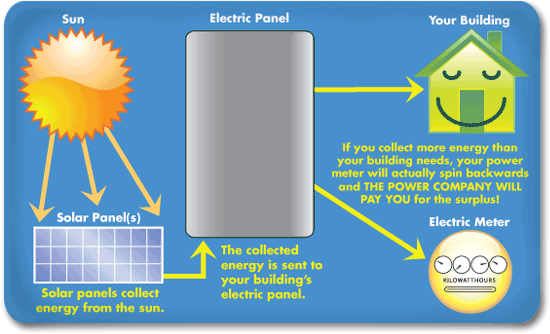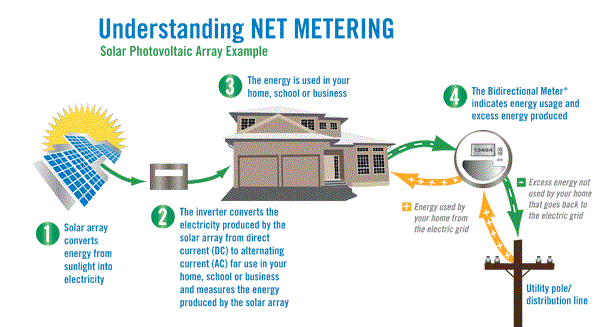How does solar power work? Here’s a quick guide to the steps that it takes to turn sunlight into electricity using solar panels:
- Every day, light hits your roof’s solar panels with photons (particles of sunlight).
- The panel converts those photons into electrons of direct current (“DC”) electricity. Naturally, the sunnier it is, the more energy is produced by the panels.
- Those produced electrons flow out of the panel and into an inverter and other electrical safety devices.
- The inverter converts that “DC” power into alternating current or “AC” power. AC power is the kind of electric juice that your television, computer, and toasters use when plugged into the wall outlet.
- A bi-directional meter keeps track of the all the power your solar system produces. Any solar energy that you don’t use immediately will go back into the grid through the meter. Then at night or on cloudy days, that extra solar juice is credited back to your bill. So, net metering is similar to having a virtual battery-backup system.
Net Metering
one of the big motivations for switching to solar power is the money you can save. Net metering takes the financial benefits one step farther: not only can you reduce your electricity bill, in many states you can actually get paid for the power you’re generating. When your solar panels produce more electricity than you need to power your home, your utility company can track your electric generation through a special meter. “Net metering” measures the difference between the amount of power you use, and the amount of power your solar panels produce.
Why do I need to be a customer of the utility company if I have solar panels?
When you’re generating your own power with solar panels, you’ll still need a way to get electricity at night or on dark days. Without a connection to the grid, you’d need an expensive battery backup system to store the extra electricity for those times. (Even though we’re called One Block Off the Grid, we’re really helping you get financially independent from the grid– not physically off the grid). By staying connected to your utility company, you’ll easily get power any time you need it. Your grid connection also makes net metering possible.
How does the meter work?
Your utility company will give you a meter that can run both forward and backward. As sunlight hits your solar panels, the panels send DC power into your inverter, where it’s changed into AC power that you can use to charge your devices. As you use that electricity, your meter will run forward normally. When your solar panels generate more power than you need, the AC power will flow back into the grid, and you’ll see the meter begin to run backward. If you live in an area that uses “time of use” or TOU billing, you’ll get a different kind of meter that can also track the time of day you’re generating electricity from your solar panels.
In locations with TOU pricing, electricity costs vary with demand; at times when more people are using power, the cost goes up. Typically, demand is highest during the middle of the day, and the price for electricity is highest then. Coincidentally, the peak demand period is the same time when your solar panels will be producing the most power. If you’re at work during the day and not using electricity– and you’re lucky enough to live in an area using TOU pricing– you can sell your excess solar power back to the utility at a time when the rates are highest.
How will I be paid?
Check with your utility company to learn how they handle payment. Typically, they’ll continue reading your meter monthly, and send you a monthly statement showing how much energy you used and how much your solar panels produced. If you used more energy than your panels provided, you’ll be billed. If you produced more energy, you’ll have a credit. You may have an option to be settling your bill either monthly or at the end of a 12-month period. Payment for credits usually happens at the end of the 12 months. In many states, you’ll be paid at the current retail rate for electricity, though some states pay for power at the wholesale rate. In some locations, the amount you can be paid is limited to a certain cap– for example, 125% of your average power use before getting solar panels. This limitation prevents people from creating oversize systems just to make money.
Where is net metering available?
More than 40 states have net metering policies, and all public electric utilities provide an option for net metering under federal law. Some states are expanding their policies to allow more solar customers to participate. California for example recently issued a ruling doubling the amount of homes eligible for net metering.
For any questions or comments or if you would like more information please contact Certified Solar.









